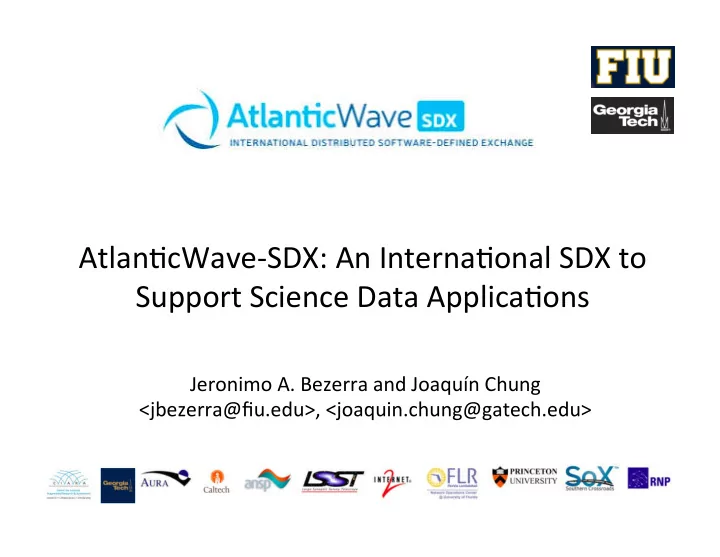

Atlan?cWave-SDX: An Interna?onal SDX to Support Science Data Applica?ons Jeronimo A. Bezerra and Joaquín Chung <jbezerra@fiu.edu>, <joaquin.chung@gatech.edu>
Outline • Introducing LSST as an Use Case – Presen?ng LSST requirements • SoOware Defined Exchanges & Scien?fic Applica?ons: – Mo?va?on – Taxonomy – Architecture – Applica?ons 2
Introducing LSST requirements • New scien?fic instruments that are being designed and deployed will increase the need for large, real-?me data transfers among scien?sts throughout the world: – the Large Synop?c Survey Telescope (LSST) being built in Chile will produce 2.7 GB images that must be transmi]ed to the U.S. in 5 seconds; – at the same ?me, the telescope will be remotely operated from Tucson, AZ. 3
Introducing LSST requirements (2) • The LSST opera?on will consist of two Channels: – Control Channel • Requires low latency, high priority, and low bandwidth • Bandwidth around a few Mbps – Data Channel • Requires high bandwidth, low latency and high priority • 2.7GB images to be sent in 5s: up to 90 Gbps • End-to-end path must provide high resilience, low delay, mul?ple paths, high bandwidth and an efficient control plane to act in all status changes 4
LSST: End-to-End Path • Most of the R&E networks can accommodate some of the LSST requirements: – Mul?ple paths with mul?ple 100G links – Dynamic provisioning, bandwidth reserva?on, network programmability, etc. • But R&E networks are interconnected through Academic Exchange Points: – Almost no support for programmability • High demanding end-to-end applica?ons requires that all networks in the path support QoS and Programmability – Including the Academic Exchange Points • SoOware Defined Exchanges as a possible solu?on 5
SDX Mo?va?on • A SoOware Defined eXchange (SDX) seeks to introduce SoOware Defined Networking (SDN) technologies into Academic Exchange Points to op?mize resource sharing and alloca?on – Inter-domain R&E network programmability – End-to-End QoS coordina?on and enforcement 6
An SDX Taxonomy 7
SDX Architectures 8
SDX Applica?ons • To augment BGP policies in an IXP: • Applica?on-specific peering • Inbound traffic engineering • Wide-area load balancing • Redirec?on through middle boxes A. Gupta, E. Katz-Basse], L. Vanbever, M. Shahbaz, S. P. Donovan, B. Schlinker, N. Feamster, J. Rexford, S. Shenker, and R. Clark, “SDX,” ACM SIGCOMM Comput. Commun. Rev., vol. 44, no. 4, pp. 551–562, Aug. 2014. 9
SDX Applica?ons (2) • Data Domain: • Data-on-demand • Data preprocessing • High-quality media transmission over long- distance networks. • Infrastructure Domain: • Data mobility for Inter-cloud use • Follow the sun (or moon) principles for Datacenter • Disaster recovery by IaaS migra?on. G. Carrozzo, R. Monno, B. Belter, R. Krzywania, K. Pen?kousis, M. Broadbent, T. Kudoh, A. Takefusa, A. Vieo-Oton, C. Fernandez, B. Puvpe, and J. Tanaka, “Large-scale SDN experiments in federated environments,” in 2014 Interna?onal 10 Conference on Smart Communica?ons in Network Technologies (SaCoNeT), 2014, pp. 1–6.
SDX Policies • Policies based on packet header field: • Match TCP or UDP source and des?na?on ports, • Match source and des?na?on IP address or • Match source and des?na?on MAC addresses • Apply ac?ons accordingly. • Policies based on external data: • Collect informa?on from other systems such as: network monitoring systems, user databases, DNS or NTP server • Match parameters such as network latency, bandwidth, user name, domain name, date and ?me • Apply ac?ons accordingly. 11
Applica?on Specific Peering if (dstport == 80) forward to B else if (dstport == 4321 || dstport == 4322) forward to C 12
More Policy examples • On-demand Virtual Circuit provisioning if (current_latency > SLA_latency) secondary = findSecondaryPath() while (current_latency > SLA_latency) LoadBalance(primary, secondary) • Bandwidth Calendaring scheduled_time = 21:00:00 GMT -5 if (current_time == scheduled_time) { BW = 90 // Bandwidth in Mbps t = 60 // Reservation time OnDemandVC(BW, t) } 13
Security Concerns for SDX • Inherited vulnerabili?es: • Layer 3 SDX à BGP • Prefix Hijacking, TCP, a]ribute manipula?on • Layer 2 SDX à Ethernet shared domain • MAC flooding, VLAN hopping, man-in-the-middle (via MAC address spoofing) • SDN SDX à Controller • Single point of failure • SDX controller is a middle-man that every par?cipant has to trust • Par?cipants would declare policies that interfere with others 14
Security Concerns for SDX (2) • Countermeasures – RPKI and S-BGP – Secure communica?on between SDX controller and par?cipants – Strong isola?on between par?cipants – Trust rela?onship between SDX controller and par?cipants 15
Ongoing Research • Explora?on of extended Pyre?c policies • Representa?on of policies as RESTful or JSON APIs • Evalua?on of new intent-based networking interfaces for SDN controllers 16
Conclusion • SDX could be used to address users’ requirements for compute, storage and networking resource sharing • SDX will evolve the Academic Exchange Point • SDX has poten?al to provide end-to-end inter- domain programmability and QoS • With SDX, LSST will be able to achieve its goals of high bandwidth availability, low latency and high priority over exis?ng R&E interconnected networks 17
Ques?ons?
Recommend
More recommend